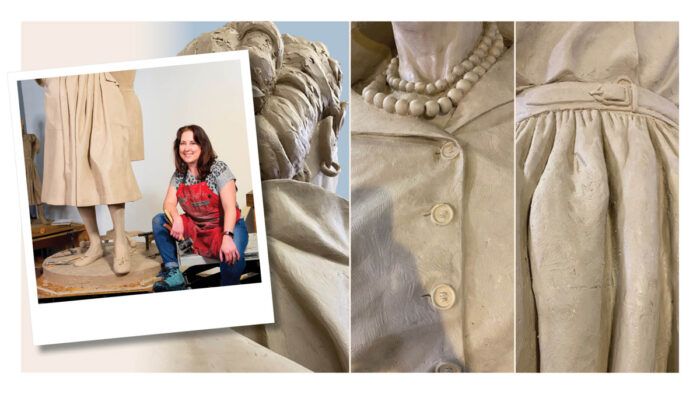
A bronze statue honoring American fashion designer Claire McCardell (1905–1958) permanently graces an urban park in her hometown of Frederick, Maryland. The public art installation, unveiled October 17, 2021, culminates an endeavor by the Frederick Art Club to pay tribute to the internationally recognized, 20th-century designer.
McCardell is credited with inventing women’s sportswear and influencing fashion ever since. The accessible designs she created from the 1930s through the 1950s combined function, comfort, and style. They won her a heap of praise, many prestigious awards, and forever fans everywhere.
Update (October 17, 2021): Click here to watch the unveiling ceremony and for more information about the statue.
Claire McCardell legacy
McCardell developed the concept of mixing and matching separates, known as the American Look. Her practical approach yielded versatile yet elegant designs. Affordable and utilitarian garments with pockets, adjustable waists, and even dolman sleeves for easy movement were McCardell hallmarks. Bias-cut designs were another.
Accolades for McCardell continue more than half a century after her death, in fashion retrospectives and museum exhibitions that include her designs. Indeed, her life and work continue to fascinate. McCardell’s 1938 Monastic dress, featured in a 2018 exhibition at the Metropolitan Museum of Art, inspired Debra Scala Giokas to write her first children’s picture book and a coloring book about the designer. Claire and Claire’s Closet (Chandelier Street, 2021), both illustrated by Mary Ryan Reeves, who hails from McCardell’s hometown, are to be released May 24, 2021.
Scala Giokas says she admires McCardell. “She had spunk. She earned her own fashion label, and that was akin to breaking the glass ceiling in those days. She deserves a statue in her honor.”
The McCardell statue project
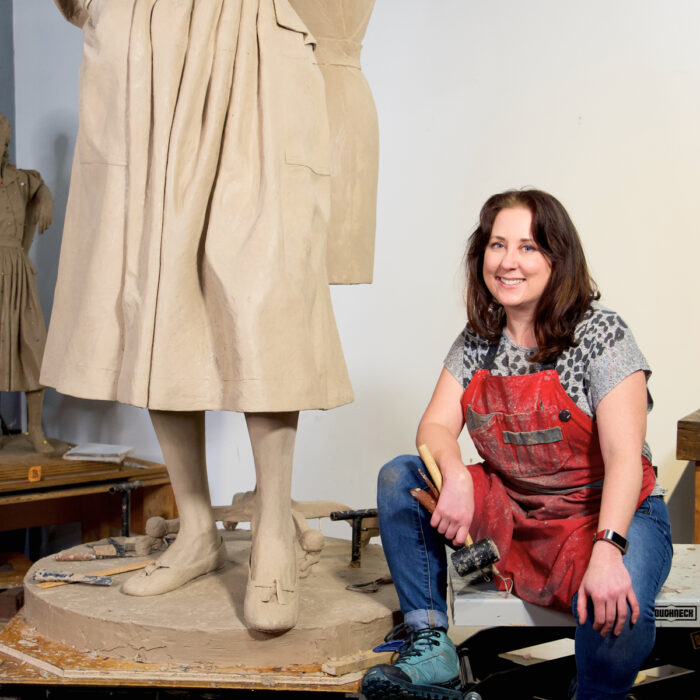
The 7 1/2-foot bronze depiction of McCardell by sculptor Sarah Hempel Irani was unveiled and presented to the City of Frederick on a breezy fall afternoon.
“In order to create a likeness of Claire McCardell, I had to get to know her personality and character,” the sculptor told those present for the unveiling. “She was introverted, independent, confident but never haughty. tenacious, and committed to do the work she was called to do—a true role model.”

Months earlier, Hempel Irani explained that she made several sculptures of the designer as she decided how to portray her. “Ultimately, I chose to depict her in one of her most popular dresses with her hand in her pocket,” she says.
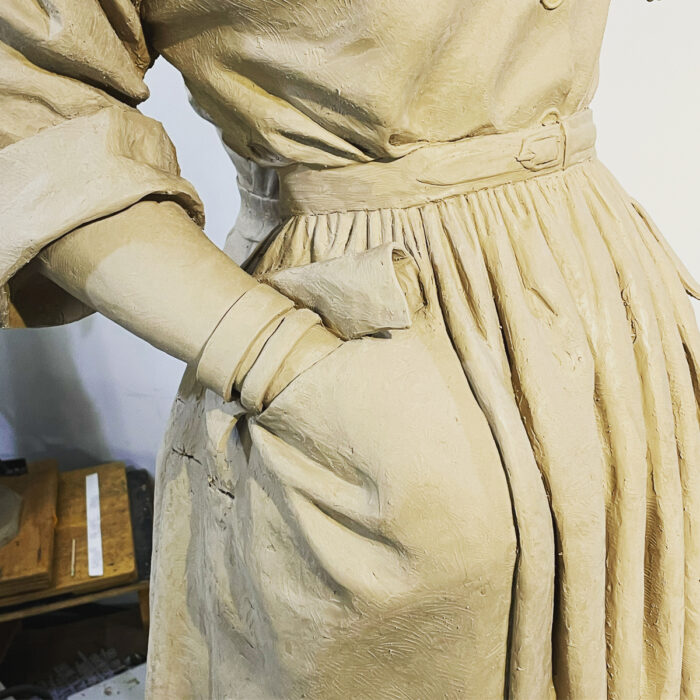
The McCardell statue is displayed on a granite pedestal at the eastern end of Frederick’s Carroll Creek Linear Park in a specially created garden. “In the garden is a wayside exhibit that includes more of Claire’s storied career, a grand photo of Claire, five of her stunning designs, and the (1955) Time magazine edition that featured her on the cover,” explains Frederick Art Club President Marilyn Bagel.
The Art Club created a video about McCardell and the bronze statue project, as well as a virtual exhibit of McCardell-inspired works by 10 of the club’s members.
The club drew from plenty of information while creating their tributes. McCardell wrote her autobiography, What Shall I Wear? (Simon and Schuster, 1956), and was feted numerous times throughout her successful career. In 1950, for example, President Truman presented her with the Woman of the Year award from the Women’s National Press Association. Fashion magazines such as Vogue repeatedly highlighted her creations on their covers during the height of her career. Even a sidewalk plaque bearing her name and one of her fashion sketches honors her on the Fashion Walk of Fame along Seventh (Fashion) Avenue in New York’s famed Garment District.
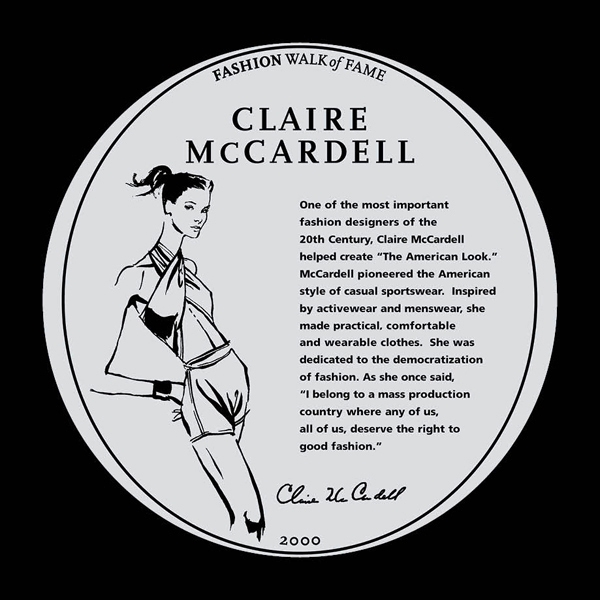
Hometown success story
McCardell grew up in Frederick, the only girl of four children, and showed an interest in fashion. She found it difficult to play in her dresses and would deconstruct her brothers’ clothes to figure out how they were made. She attended Hood College and then the Parsons School of Design.
Her early years working in the industry were a struggle, but she gained traction with her Monastic dress, created while at Townley Frocks in 1938. The full, bias-cut dress that had no darts and hung from the shoulders was belted or tied at the waist for shape. Later came the Pop-over dress, meant to be worn alone or “popped over” another garment while at work in the home. The popular front-wrap dress debuted in 1942 and featured a patch pocket on the front with a matching oven mitt. It retailed for $6.95.
When it came to fabrics, McCardell chose natural fibers like cotton and wool, and often went with sturdy textiles like denim—as in the Pop-over dress. The fabrics were long-wearing and readily available during World War II rationing.
Her affordable, ready-to-wear, and easy-to-care for creations appealed to many style-conscious consumers.
McCardell succumbed to colon cancer in 1958. She was just 52. But her aesthetic and timeless designs continue to influence how women dress.
Sources
“Pop-over.” Claire McCardell dress, 1942. Metropolitan Museum of Art, https://www.metmuseum.org/art/collection/search/84029
Le Zotte, Jennifer. “What a 1950s Fashion Maven Might Teach Us About What To Wear.” Smithsonian.com, Smithsonian Institution, 8 June 2015, https://www.smithsonianmag.com/smithsonian-institution/1950s-designer-claire-mccardell-might-teach-us-about-what-wear-180955520/
Evitts Dickinson, Elizabeth. “A Dress for Everyone.” Washington Post Magazine, December 12, 2018, https://www.washingtonpost.com/news/magazine/wp/2018/12/12/feature/the-designer-who-radically-suggested-that-women-should-wear-whats-comfortable/



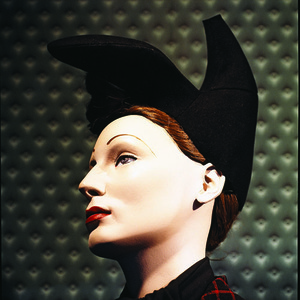



























Log in or create an account to post a comment.
Sign up Log in